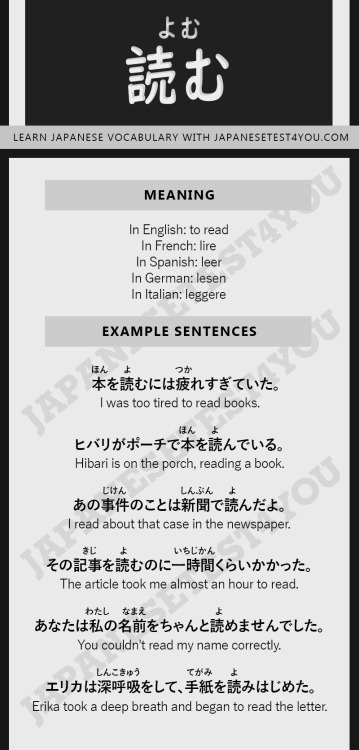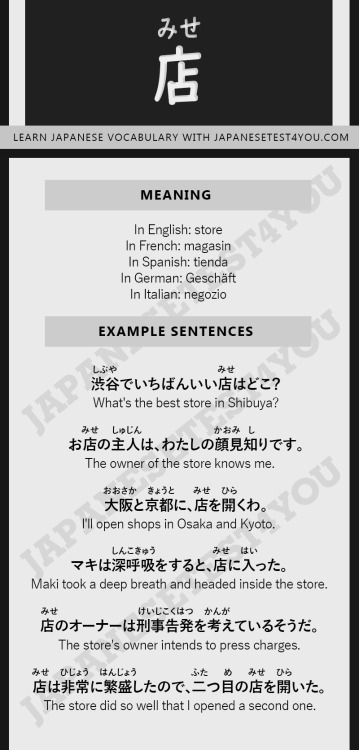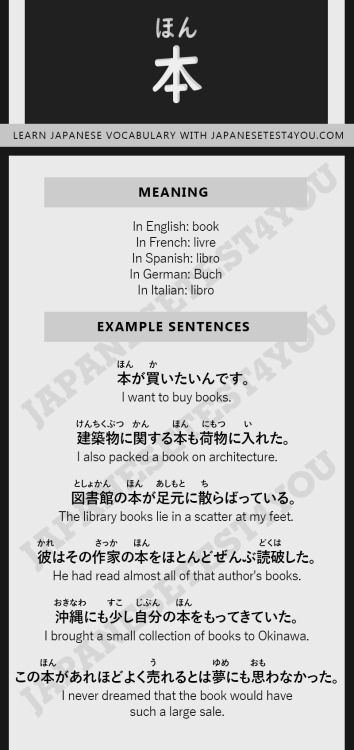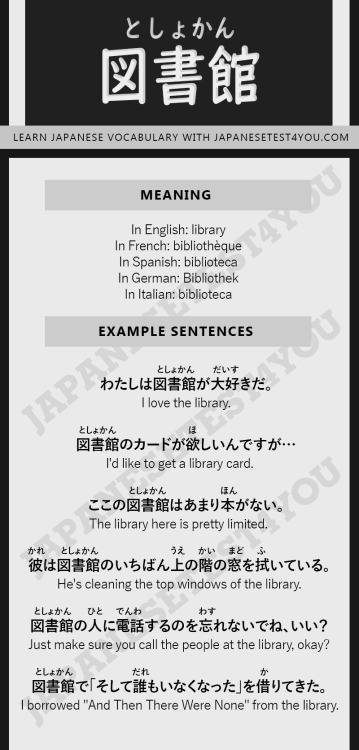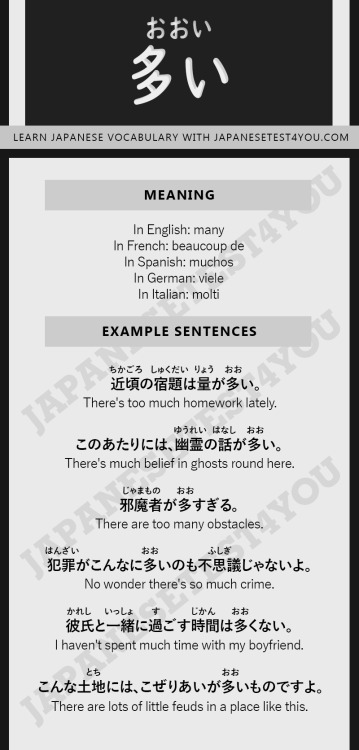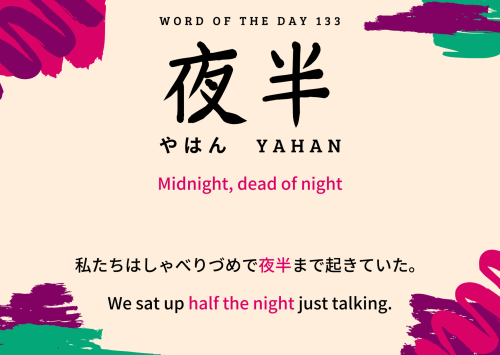#jlpt n5
JLPT Level: Unlisted, but the kanji are N4 and N5 respectively.
This is a pretty low-frequency word. It sounds pretty old-timey, and it makes sense because I found it in a manga that takes place in the Edo Period haha.
Let’s take a look at the kanji:
夜
- On-yomi: ya
- Kun-yomi: yo, yoru
- Meaning: night, evening
半
- On-yomi: han
- Kun-yomi: naka.ba
- Meaning: half, middle, odd number, semi-, part-
Put them together and you get “the middle of the night.” Pretty easy, right?
Post link
単語 (たんご) Frequency Adverbs
not much 余り (あまり)
not at all 全然 (ぜんぜん)
usually 大抵 (たいてい)
sometimes 時々 (ときどき)
often; much よく (良く)
at about… ぐらい
Frequency Adverb Grammar
Frequency adverbs are added to a sentence to describe how often you do something.
I sometimes go to a coffee shop.
私はときどききっさてんに行きます。
Negative frequency adverbs anticipate a negative verb form at the end of the sentence. Therefore, you cannot use ぜんぜん or あまり with a positive verb form such as ます to communicate their meanings here. They would have to be used with ません!!
Ie. 私は全然テレビを見ません。
I do not watch TV at all.
Genki Vocabulary
Here are some words from chapters six through eight :)
もちろん of course
良かったら if you like
太る(ふとる) to gain weight
速い(はやい) fast
すぐ right away
背が低い(せがひくい)short
つける to turn on
着る(きる)to put on clothes above waist
短い(みじかい)short in length
おりる to get off
勤める(つとめる)to work for
親切 (しんせつ)kind
閉める(しめる) to close something
やせる to lose weight
知る(しる) to get to know
遅く(おそく)late
結婚する(けっこんする)to get married
はく to put on (items below your waist)
長い (ながい) long
出かける to go out
やさしい easy (problem)
にぎやか lively
荷物(にもつ)baggage
夜(よる)evening; sunset
大変(たいへん)tough situation
返す(かえす)to return (item)
使う(つかう) to use
手伝う(てつだう)to help
持つ (もつ) to carry; to hold
降りる(おりる)to get off
借りる(かりる) to borrow
閉める(しめる)to close something
つける to turn on
電話をかける(でんわをかける)to make a phone call
連れてくる(つれてくる)to bring a person (irregular verb)
持ってくる(もってくる)to bring a thing (irregular verb)
遅く(おそく) (do something) late
会社(かいしゃ)company
家族(かぞく)family
兄弟(きょうだい)siblings
国(くに)country
食堂(しょくどう)cafeteria
眼鏡(めがね)glasses
背が高い(せがたかい)tall
背が低い(せがひくい)short
短い(みじかい)short (length)
親切(しんせつ)kind
便利 (べんり)convenient
かぶる to put on a hat
知る(しる)to get to know
知っています I know
知りません I do not know
はく to put on (items below your waist)
太る(ふとる)to gain weight
太っています to be on the heavy side
CHAPTER 8
空気(くうき)air
今朝(けさ)this morning
黒板(こくばん)blackboard
今月(こんげつ)this month
大学生(だいがくせい)college student
天気予報(てんきよほう)
所(ところ)place
夏(なつ)summer
何か(なにか)something
パーティー party
はし chopsticks
冬(ふゆ) winter
毎週 (まいしゅう)every week
来月(らいげつ) next month
上手(じょうず)skillful; good at
下手 (へた) clumsy; poor at
有名(ゆうめい)famous
My new learning system ~
Hiii, here’s how I have been learning Japanese these past couple of weeks!
I have been learning my kanji with The Kodansha Kanji Learner’s Course. I learn 2+ kanji a day, along with a corresponding vocabulary word for each one. I think this is nice because I am killing two birds with one stone by learning a reading of the kanji and the vocabulary word at once!
First, I review the previous day’s kanji by writing it down. I will review up to a week’s worth of kanji sometimes.
Then, I write down the new kanji I learn at the back of my notebook. I will include the words and stroke order beside them.
The next day, IN A DIFFERENT NOTEBOOK, I write the previous day’s vocabulary words (which are made up of the kanji) review. The second day notebook is what I use as a “I should probably know this or at least be somewhat familiar with this” kind of thing. Side note: If I learn 2 kanji a day, I should be able to finish the book (and learn a lot of vocabulary!) in under 10 months.
I have also been using WaniKani. I don’t know how to feel about it yet. I have however been taking words I struggle to remember and putting them on sticky notes and placing them on what I call my “focus wall” beside my desk. None of those words should be lying dormant on the wall for more than a week. I add them to a corresponding “focus” flashcard set on the Shirabe Jisho app to give them extra attention
I use the Shirabe Dictionary app for a lot of things, but mostly last minute kanji and vocabulary refreshers. It’s PACKED with value because it offers example sentences, stroke order, built in flash card sets (and an SRS system for them), word lists and kanji lists, etc. You can customize your own sets too if you want. The only thing is, don’t rely on the audio for the vocabulary. It’s not great. Still, I’m shocked that it’s free.
I’ve also been using HelloTalk. I actually quite love the listening they offer on there because it isn’t too difficult for beginners but there are intermediate options as well. They offer vocabulary and grammar explanations with listening that is suited for my level, which I really found most other podcasts to be lacking. Note: Another fun thing is just texting native Japanese speakers on there. It’s rly useful for learning their common phrases, especially because there’s a translation feature. It also kind of has the same features as HiNative, so I find it to be better in my opinion.
I found that I struggle with reading enough example sentences, so I scurried to my genki textbook to look at the fundamentals. I also use Japanese Sentence Patterns for Effective Communication. I like it, but the Romaji is quite annoying. Other than that, I find the example sentences to be pretty extensive!
Any other grammar I’m learning comes from a mixture of Cure Dolly (don’t binge her videos after the 4th episode, you will quickly regret it. It adds up too fast. Try to supplement her videos with beginner articles or other videos on the topic, then PRACTICE and EXERCISE making sentences before moving on), various blog articles (Ie. Tofugu) and my textbook (Genki).
So yeah. I also sometimes practice reading with the book Japanese Short Stories for Beginners by LingoMastery. I really like it, especially because it also includes vocabulary to learn with the stories. It’s written pretty formally so it will complement the traditional western learning style textbooks nicely.
Anyway, that’s how I’m studying lately. For me, I find the Kanji and their vocabulary to be daily, listening practice to be almost daily, and WaniKani almost daily. My weakness is reading and speaking. I usually speak when i’m imitating native speakers or the lessons from HelloTalk, but I’m not quite good enough to actually talk to native speakers yet.
Anyway, I’m off to sleep. Hope this helped! お休みなさい!
JLPT N5 Grammar - てください
Are you using it right??
How do you ask someone to do something without sounding like a teacher? Hint: not like this!
————-
Welcome to Benkyogo!
In our ぶんぽうご Real Japanese Grammar series, Nani and Mani are deep diving into the textbook grammar required for the JLPT, throwing out the stuff you’ll never use, and teaching you how to speak authentically whilst expressing your own personality.
⭕️ You WILL:
- Understand grammar in real life context- Be told when and where to forget the BS - Get to listen to 2 random people free-talking about Japanese grammar
❌ You WON’T:
- Sound boring when talking to your Japanese friends - Say anything rude to your Japanese boss - Speak like you’re fresh outta your favourite anime
We don’t claim to be experts, we’re just 2 Japanese speakers (one native, one second language) chatting about the DO’s and DON’T’s of Japanese grammar in the 21st century. Keep up, textbooks!!
————-
Check out https://benkyogo.co.uk/ for detailed hints, tips and resources to self-study Japanese.
⛩Check out our store at https://www.etsy.com/shop/benkyogo
JLPT N5 Grammar - でも
Are you using it right??
でも seems like a great way to say “but” BUT… there’s a big but. There are politer (and more native-sounding) ways to say BUT. Learn about all the buts on this episode of Bunpogo!
————-
Welcome to Benkyogo!
In our ぶんぽうご Real Japanese Grammar series, Nani and Mani are deep diving into the textbook grammar required for the JLPT, throwing out the stuff you’ll never use, and teaching you how to speak authentically whilst expressing your own personality.
⭕️ You WILL:
- Understand grammar in real life context- Be told when and where to forget the BS - Get to listen to 2 random people free-talking about Japanese grammar
❌ You WON’T:
- Sound boring when talking to your Japanese friends - Say anything rude to your Japanese boss - Speak like you’re fresh outta your favourite anime
We don’t claim to be experts, we’re just 2 Japanese speakers (one native, one second language) chatting about the DO’s and DON’T’s of Japanese grammar in the 21st century. Keep up, textbooks!!
————-
Check out https://benkyogo.co.uk/ for detailed hints, tips and resources to self-study Japanese.
⛩Check out our store at https://www.etsy.com/shop/benkyogo
JLPT N5 Grammar - しなければいけない・ならない
Are you using it right??
These double negatives are super confusing, but we explain the basics of the “have to”’s in this episode of Bunpogo!
————-
Welcome to Benkyogo!
In our ぶんぽうご Real Japanese Grammar series, Nani and Mani are deep diving into the textbook grammar required for the JLPT, throwing out the stuff you’ll never use, and teaching you how to speak authentically whilst expressing your own personality.
⭕️ You WILL:
- Understand grammar in real life context- Be told when and where to forget the BS - Get to listen to 2 random people free-talking about Japanese grammar
❌ You WON’T:
- Sound boring when talking to your Japanese friends - Say anything rude to your Japanese boss - Speak like you’re fresh outta your favourite anime
We don’t claim to be experts, we’re just 2 Japanese speakers (one native, one second language) chatting about the DO’s and DON’T’s of Japanese grammar in the 21st century. Keep up
JLPT N5 Grammar - 〜たい
Are you using it right??
Tell people what you want without sounding like a nagging child in this episode of Bunpogo, JLPT5! The grammar point is… 〜たい.
————-
Welcome to Benkyogo!
In our ぶんぽうご Real Japanese Grammar series, Nani and Mani are deep diving into the textbook grammar required for the JLPT, throwing out the stuff you’ll never use, and teaching you how to speak authentically whilst expressing your own personality.
⭕️ You WILL:
- Understand grammar in real life context- Be told when and where to forget the BS - Get to listen to 2 random people free-talking about Japanese grammar
❌ You WON’T:
- Sound boring when talking to your Japanese friends - Say anything rude to your Japanese boss - Speak like you’re fresh outta your favourite anime
We don’t claim to be experts, we’re just 2 Japanese speakers (one native, one second language) chatting about the DO’s and DON’T’s of Japanese grammar in the 21st century. Keep up, textbooks!!
————-
Check out https://benkyogo.co.uk/for detailed hints, tips and resources to self-study Japanese.
⛩Check out our store at https://www.etsy.com/shop/benkyogo
JLPT N2 Grammar - ちなみに
Are you using it right??
Challenge yourself with JLPT N2 and the difference between ちなみに and とにかく. We find out which means what and – can I change the subject now?
————-
Welcome to Benkyogo!
In our ぶんぽうご Real Japanese Grammar series, Nani and Mani are deep diving into the textbook grammar required for the JLPT, throwing out the stuff you’ll never use, and teaching you how to speak authentically whilst expressing your own personality.
⭕️ You WILL:
- Understand grammar in real life context- Be told when and where to forget the BS - Get to listen to 2 random people free-talking about Japanese grammar
❌ You WON’T:
- Sound boring when talking to your Japanese friends - Say anything rude to your Japanese boss - Speak like you’re fresh outta your favourite anime
We don’t claim to be experts, we’re just 2 Japanese speakers (one native, one second language) chatting about the DO’s and DON’T’s of Japanese grammar in the 21st century. Keep up, textbooks!!
————-
Check out https://benkyogo.co.uk/for detailed hints, tips and resources to self-study Japanese.
⛩Check out our store at https://www.etsy.com/shop/benkyogo

